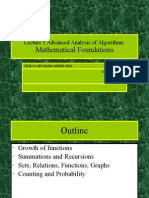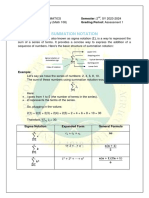Combinatorics-II
Catalan Numbers
Introduction
There are a number of concepts that could be solved using Catalan numbers.
Catalan numbers are a succession of positive numbers that show up in many
counting problems in combinatorics. They count particular sorts of grid ways,
permutations, binary trees, and numerous other combinatorial items. They fulfill a
principal recurrence relation.
Catalan numbers are a set of positive integers that appear in many combinatorial
counting problems like the hand-shake problem, total number of paths from [0,0]
to [n,n] where you can’t move on diagonal elements etc. They keep track of lattice
pathways, permutations, binary trees, and a wide range of other combinatorial
objects. They have a closed-form formula in terms of binomial coefficients and
satisfy a fundamental recurrence relation.
Sample Problems:
1. Find the total number of ways from point (0, 0) to reach (n, n). You can’t
cross the diagonal and you cannot use the diagonal path.
2. Triangulation problem: You are given a polygon with n + 2 vertices. How
many triangles can you draw inside the given polygon using its diagonals?
The diagonals must not cut each other.
1
� 3. How many different binary trees can be drawn with n nodes?
Now, with the following process, we have found out, For a given ‘n’ number of
nodes, how many ways it can be represented as a binary tree.
1. Define an array of size n and put arr[0] = 1.
2. For n = 1, there is one possible representation of a binary tree. Hence,
update the arr[1] = 1.
3. For n = 2, there are two configurations of binary trees possible. Hence,
update the arr[2] = 2.
4. For n = 3, there are five possible configurations of binary trees. Hence,
arr[3] = 5.
2
�5. Hence, we can standardize the number of possible configurations of left
and right nodes as products of their respective array values, as shown in
the diagram.
6. Similarly, for n = 4, the possible number of nodes are
3
�Code:
#include <iostream>
using namespace std;
unsigned long int catalan(unsigned int n)
{
if (n <= 1)
return 1;
// catalan(n) is sum of catalan(i)*catalan(n-i-1)
unsigned long int res = 0;
for (int i = 0; i < n; i++)
res += catalan(i)
* catalan(n - i - 1);
return res;
}
int main()
{
for (int i = 0; i < 10; i++)
cout << catalan(i) << " ";
return 0;
}
Time Complexity:
O (N2), where N is the number of nodes in the tree.
Inclusion Exclusion
Introduction:
It is a very easy technique, which could be used to solve many complicated
problems like the Hat-Check Problem i.e. to determine the number of
derangements (or permutations) of n objects such that no object is in its original
position. The inclusion-exclusion can help you evaluate the UNION of N sets by
their intersection.
Example:
4
� ● Suppose, we have to find the total number of elements between 1 to 10
either divisible by 2 or 5 .
A = [2, 4, 6, 8, 10]
B = [5, 10]
|A ∪ B| = |A| + |B| + |A ∩ B|
= 5 + 2 -1
=6
● Hence, for the total number of elements divisible by a,b and c
Live Problem - NGM2 - Another Game with Numbers
Problem Statement:
Little Chikoo likes to play with numbers. Often he plays the following game:
1. He chooses a number N and a set of positive integers.
2. He writes down all the numbers from 1 to N.
5
� 3. He chooses the first number (say x) from the set and cancels out all the
multiples of x from 1 to N, including x.
He repeats step 3 for all the numbers from the set.
One day Little Chikoo was in the mood to play pranks. So his brother asked him to
play the game with a certain challenge. He made the game a little harder and
asked him to find out the number of integers that aren't cancelled after he
completes step 4. If he does that then Little Chikoo gets to play on his brother's
Nintendo for one full day. Now Little Chikoo is in a hurry and wants to finish the
job as soon as possible. He has asked for your help.
Approach:
If we think carefully, then we can understand that in the question we have to
find the number of integers that are not divisible by any integer given in the set.
To achieve that we can follow the following steps.
● First of all, we can convert the question a little bit. Instead of finding the
number of integers that are not divisible by any integer given in the set,
we can simply find the number which is divisible by at least one number
and subtract it from N. (i.e N - {number divisible by at least one
integer}).
● N is already given to us therefore, we just need to find the second part of
the equation described above.
6
� ● It is easy to find out that the number of integers (x) which are divisible by
a given integer in the range (1 to N) is simply [N/x] (rounded down). But
if we do it for all the integers given in the set it will give us a wrong
answer because of double counting (Because there can be an integer
that is divisible by more than one given integer but we have to count it
only once).
● To resolve the above-mentioned problem we use the principle of
inclusion-exclusion. If we think carefully we want to calculate (F(a1) ∪
F(a2)....F(ak)).
● Where ai is the given divisor and F(ai) means numbers of integers
divisible by ai in the range 1 to N.
● As we discussed above that (F(a1) ∪ F(a2)....∪ F(ak)) = (F(a1) + F(a2)....+
F(ak)) - (F(a1) ∩ F(a2)....∩ F(ak))(all pair of intersection).
● It is simple to find (F(a1) + F(a2)....+ F(ak)) because F(ai) is nothing but
equal to N/ai. Now to find the intersection we can say that (F(ai) ∩
F(ai+1)) is equal to the N/LCM(ai,ai+1).
● In order to find the intersection of all the pairs of divisors, we can use bit
masking for more clarity. You can refer to the following implementation.
Code:
#include<bits/stdc++.h>
#define ll long long int
using namespace std;
ll calculateLCM(ll a , ll b){
if(a == 0) return b;
return (a * b) / __gcd(a , b);
}
int main(){
ll n , k , res = 0;
int ar[15];
7
� cin>>n>>k;
for(int i=0;i<k;i++) cin>>ar[i];
for(int mask=1;mask<(1 << k);mask++){
ll lcm = 0;
int count = 0;
for(int i=0;i<15;i++)
if(mask & (1 << i)){
lcm = calculateLCM(lcm , ar[i]);
count++;
}
if(count % 2) res += n / lcm;
else res -= n / lcm;
}
cout<<n - res;
}
Pigeon Hole Principle
Introduction:
This principle simply states that there are N numbers of pigeons and we have to
put these into (N-1) holes. Each of them needs to go exactly one of the holes,
then at least one of the pigeons has to share the hole. The concept is very easy,
and it could be used to solve many different problem questions.
Suppose that a flock of 20 pigeons flies into a set of 19 pigeonholes to roost.
Because there are 20 pigeons but only 19 pigeonholes, at least one of these 19
pigeonholes must have at least two pigeons in it. This illustrates a general
principle called the pigeonhole principle, which states that if there are more
pigeons than pigeonholes, then there must be at least one pigeonhole with at
least two pigeons in it.
8
�Example :
Suppose, we have to prove that there exist two numbers between 20 and 30, such
that their difference is also divided by 9. The possible remainders when a number
is divided by 9 are - 0, 1, 2,3,4,5,6,7,8, that is, 9 numbers.
Hence, we can conclude that there are at least 2 numbers, having the same
remainder.
a1 = 9 * d1 + r1
a2 = 9 * d2 + r1
(a1 - a2) = (9d1 - 9d2)
= 9 (d1 - d2)
9 (𝑑1 − 𝑑2)
= 9
Live Problem: Hallow - Halloween Treats
Problems Statement:
9
�Every year there is the same problem at Halloween: Each neighbour is only
willing to give a certain total number of sweets on that day, no matter how
many children call on him, so it may happen that a child will get nothing if it is
too late. To avoid conflicts, the children have decided they will put all sweets
together and then divide them evenly among themselves. From last year's
experience of Halloween, they know how many sweets they get from each
neighbor. Since they care more about justice than about the number of sweets
they get, they want to select a subset of the neighbors to visit, so that in sharing
every child receives the same number of sweets. They will not be satisfied if
they have any sweets left which cannot be divided. Your job is to help the
children and present a solution.
Approach:
● First, we are going to find the prefix sum, from the given elements. Because
we can see that sum of any range L to R can represent using prefix sum as
Sum(L,R) = (prefixSum(R) - prefixSum(L-1)), Also modulo is an associative
property under addition. Therefore, prefixSum will help us to find whether
the sum of the subarray is divisible by the number of children (c) or not.
● Now we compute prefixSum modulo c, which will be stored in another
array. Now, wherever we get zero or equal remainder, then there exists a
solution from [previous position + 1] till [last position]. Because if we get
a zero it means that the sum from the first position to that position is
divisible by c. Else if we find that the remainder at two different positions is
equal it means that the sum of the range between these two positions is
divisible by c.
● Now, if the remainder is zero it means we can distribute equal candies to all
the children
10
�Code:
#include<bits/stdc++.h>
using namespace std;
const int N = 1e5;
long long pre[N+1];
int rem[N+1];
int main(){
int c , n, x;
while(true){
cin>>c>>n;
if(c+n == 0) break;
//rem[i] = position where prefix_sum % c = i
for(int i=1;i<c;i++) rem[i] = -1;
rem[0] = 0;
for(int i=1;i<=n;i++) {
cin>>x;
pre[i] = pre[i-1] + x;
}
for(int i=1;i<=n;i++){
int r = pre[i] % c;
if(rem[r] != -1){
for(int L = rem[r]+1;L<=i;L++) cout<<L<<" ";
cout<<endl;
break;
}
else{
rem[r] = i;
}
}
}
11





























































































